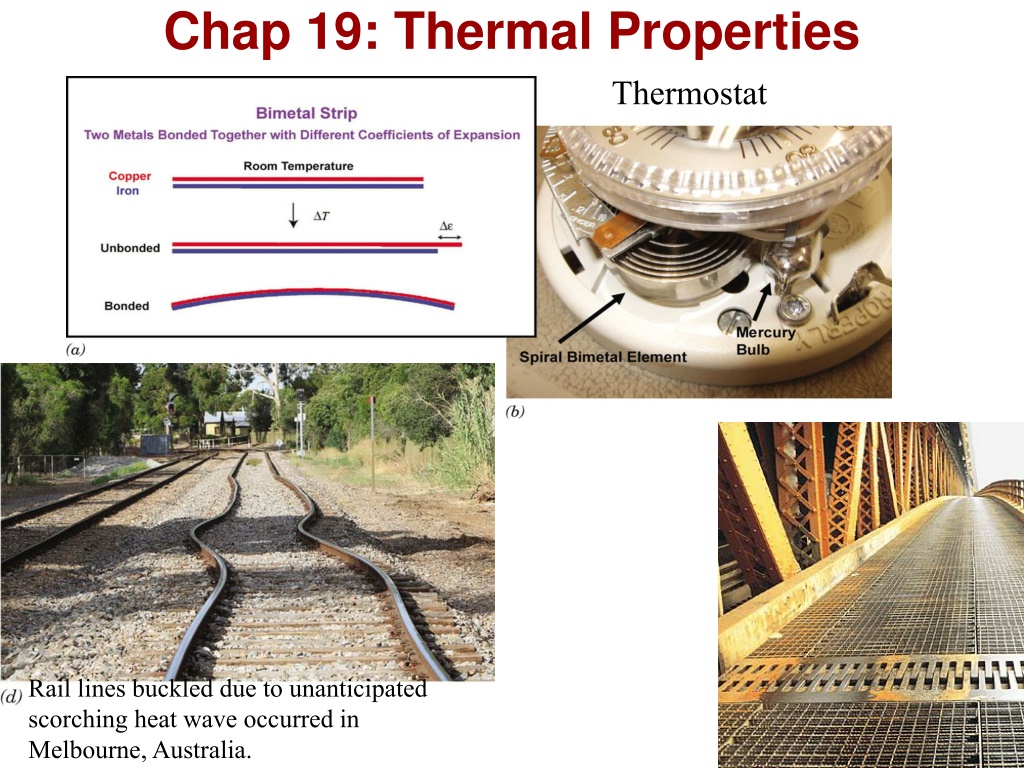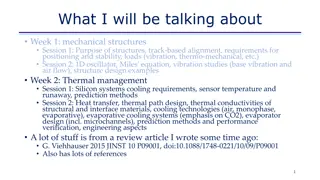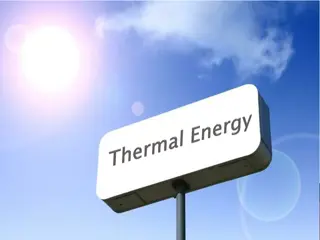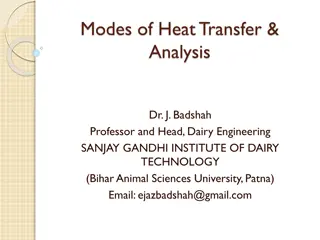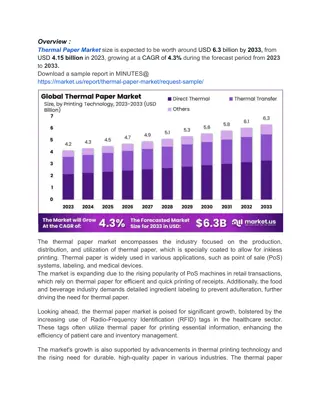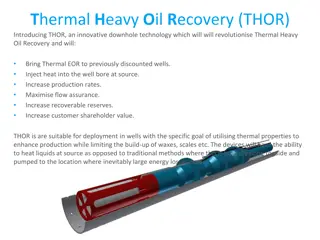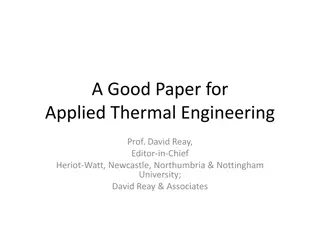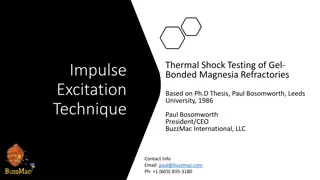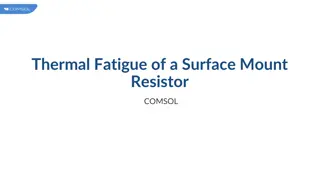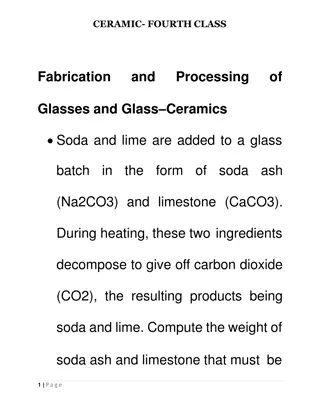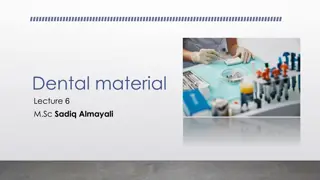Understanding Thermal Properties of Materials
Explore the thermal properties of materials in Chapter 19, covering concepts such as heat capacity, thermal expansion, conductivity, shock resistance, and differences among ceramics, metals, and polymers. Delve into topics such as heat absorption, specific heat capacity, atomic vibrations, and the influence of temperature on heat capacity. Discover how materials respond to heat and the significance of measuring and defining properties like heat capacity. Gain insights into the speed of sound in air and its relationship with temperature.
Download Presentation

Please find below an Image/Link to download the presentation.
The content on the website is provided AS IS for your information and personal use only. It may not be sold, licensed, or shared on other websites without obtaining consent from the author. Download presentation by click this link. If you encounter any issues during the download, it is possible that the publisher has removed the file from their server.
E N D
Presentation Transcript
Chap 19: Thermal Properties Thermostat Rail lines buckled due to unanticipated scorching heat wave occurred in Melbourne, Australia. Chapter 19 -
Chapter 19: Thermal Properties ISSUES TO ADDRESS... How do materials respond to the application of heat? How do we define and measure... -- heat capacity? -- thermal expansion? -- thermal conductivity? -- thermal shock resistance? How do the thermal properties of ceramics, metals, and polymers differ? Chapter 19 - 2
Heat Capacity The ability of a material to absorb heat Quantitatively: The energy required to produce a unit rise in temperature for one mole of a material. energy input (J/mol) dQ heat capacity (J/mol-K) C = dT temperature change (K) Two ways to measure heat capacity: Cp : Heat capacity at constant pressure. Cv : Heat capacity at constant volume. Solids: Cp= Cv Gases: Cp> Cv J Btu Heat capacity has units of mol K lb mol F Chapter 19 - 3
Speed of sound in air (in m/s) at temperature T (in Kelvin) is given by; kT v = m where = 1.40 (ratio of specific heats for air = Cp/Cv), m = 4.8 x 10-26 kg (average molecular mass of air), and k = 1.38 x 10-23 J/K (Boltzmann constant). a. Calculate the average molecular mass of air (assume dry air, no H2O) using the three most abundant gases found in the Earth s lower atmosphere. http://www.physicalgeography.net/fundamentals/7a.html b. Calculate the speed of sound in air at RT, 293K. Chapter 19 - 4
Dependence of Heat Capacity on Temperature Heat capacity... -- increases with temperature -- for solids it reaches a limiting value of 3R Cv= constant R = gas constant 3R = 8.31 J/mol-K Adapted from Fig. 19.2, Callister & Rethwisch 8e. 0 T (K) D 0 Debye temperature (usually less than Troom) From atomic perspective: -- Energy is stored as atomic vibrations. -- As temperatureincreases, the average energy of atomic vibrations increases. Chapter 19 - 5
Atomic Vibrations Atomic vibrations are in the form of lattice waves or phonons. A phonon is analogous to the photon in electromagnetic radiation. Chapter 19 -
Specific Heat Capacity The heat Q that must be supplied or removed to change the temperature of a substance of mass m by an amount T is, where c is the specific heat capacity of the substance. Unit for Specific Heat Capacity: SI: J/(kg C ) cgs: cal/(g. C ) Chapter 19 -
Specific Heat: Comparison cp (J/kg-K) at room T 1925 1850 1170 1050 Material Polymers Polypropylene Polyethylene Polystyrene Teflon cp(specific heat): (J/kg-K) Cp(heat capacity): (J/mol-K) increasing cp Ceramics Magnesia (MgO) Alumina (Al2O3) Glass 940 775 840 Metals Aluminum Steel Tungsten Gold 900 486 138 128 Selected values from Table 19.1, Callister & Rethwisch 8e. Chapter 19 - 8
3R At low temperatures the relationship between Cv and the absolute temperature is .. Eq. 19.2 0 T (K) Chapter 19 -
19.1 Estimate the energy required to raise the temperature of 2 kg (4.42 lbm) of the following materials from 20 to 100 C (68 to 212 F): aluminum, steel, soda lime glass, and high-density polyethylene. Chapter 19 -11
Thermal Expansion Materials change size when temperature is changed Tinitial initial Tfinal> Tinitial Tfinal final lfinal linitial linitial linear coefficient of thermal expansion (1/K or 1/ C) = l(Tfinal Tinitial) Chapter 19 -
Atomic Perspective: Thermal Expansion Asymmetric curve: -- increase temperature, -- increase in interatomic separation -- thermal expansion Symmetric curve: -- increase temperature, -- no increase in interatomic separation -- no thermal expansion Chapter 19 -13 Adapted from Fig. 19.3, Callister & Rethwisch 8e.
Coefficient of Thermal Expansion: Comparison (10-6/ C) at room T Material Polymers Polymers have larger values because of weak secondary bonds Polypropylene Polyethylene Polystyrene Teflon Metals Aluminum Steel Tungsten Gold 145-180 106-198 90-150 126-216 Q: Why does generally decrease with increasing bond energy? increasing 23.6 12 4.5 14.2 A: The greater the bond energy, the deeper and more narrow this potential energy trough. Ceramics Magnesia (MgO) Alumina (Al2O3) Soda-lime glass Silica (cryst. SiO2) 13.5 7.6 9 0.4 Chapter 19 -14
Thermal Expansion: Example Ex: A copper wire 15 m long is cooled from 40 to -9 C. How much change in length will it experience? = 6 1 17 10 x ( C) Answer: For Cu rearranging Equation 19.3b = [ = 6 17 x 10 / 1 ( C )]( 15 m [ ) 40 C ( 9 C )] T 0 . 0 = = 0125 m 12.5 mm Chapter 19 -15
Invar and Other Low-Expansion Alloys Invar means invariable length. Charles-Edouard Guillaume won the 1920 Nobel prize in physics for discovering Invar: 64 wt% Fe-36 wt% Ni. As a specimen of Invar is heated, within its Curie temperature (~2300C), its tendency to expand is countered by a contraction phenomenon that is associated with its ferromagnetic properties (magnetostriction). Super Invar: 63 wt% Fe, 32 wt% Ni, and 5 wt% Co. Kovar: 54 wt% Fe, 29 wt% Ni, and 17 wt% Co. Its thermal expansion is similar to that of Pyrex glass. http://www.youtube.com/watch?v=ZoGBjGKlLcU Chapter 19 - 16
Thermal expansion of concrete and Steel https://www.fhwa.dot.gov/publications/research/infrastructure/pa vements/pccp/thermal.cfm Chapter 19 - 17
Thermal expansion coefficient of human teeth and dental composites https://www.ncbi.nlm.nih.gov/pubmed/2619623 https://www.ncbi.nlm.nih.gov/pubmed/9170996 Chapter 19 - 18
